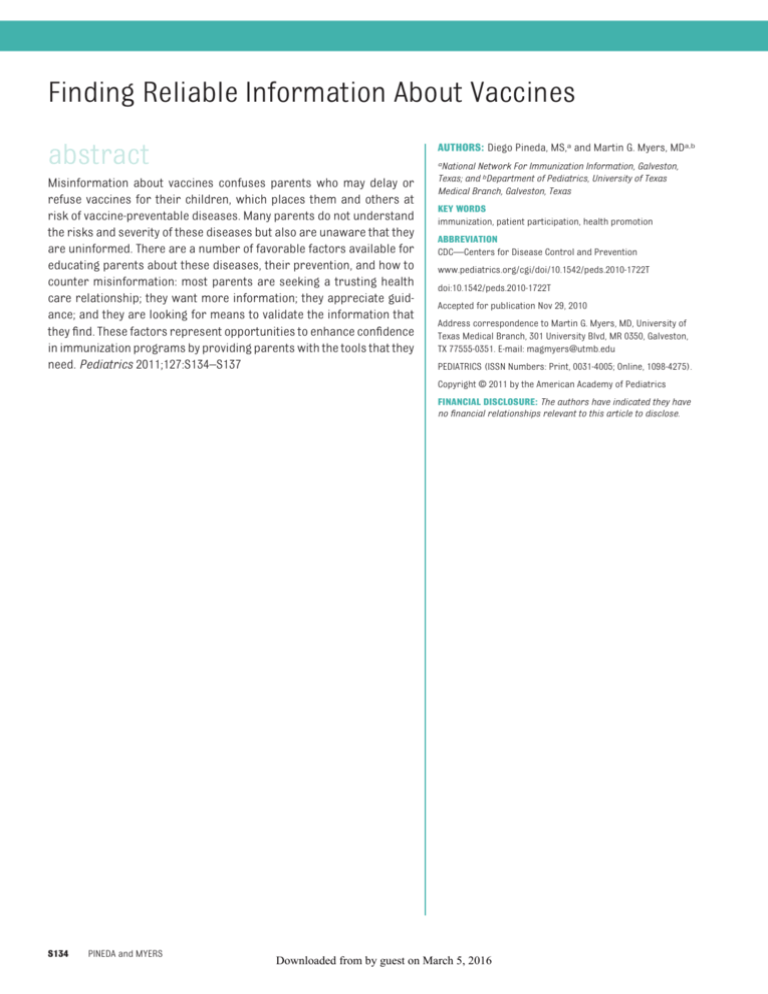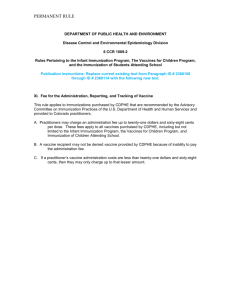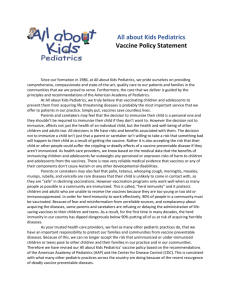
Finding Reliable Information About Vaccines
AUTHORS: Diego Pineda, MS,a and Martin G. Myers, MDa,b
abstract
Misinformation about vaccines confuses parents who may delay or
refuse vaccines for their children, which places them and others at
risk of vaccine-preventable diseases. Many parents do not understand
the risks and severity of these diseases but also are unaware that they
are uninformed. There are a number of favorable factors available for
educating parents about these diseases, their prevention, and how to
counter misinformation: most parents are seeking a trusting health
care relationship; they want more information; they appreciate guidance; and they are looking for means to validate the information that
they find. These factors represent opportunities to enhance confidence
in immunization programs by providing parents with the tools that they
need. Pediatrics 2011;127:S134–S137
aNational Network For Immunization Information, Galveston,
Texas; and bDepartment of Pediatrics, University of Texas
Medical Branch, Galveston, Texas
KEY WORDS
immunization, patient participation, health promotion
ABBREVIATION
CDC—Centers for Disease Control and Prevention
www.pediatrics.org/cgi/doi/10.1542/peds.2010-1722T
doi:10.1542/peds.2010-1722T
Accepted for publication Nov 29, 2010
Address correspondence to Martin G. Myers, MD, University of
Texas Medical Branch, 301 University Blvd, MR 0350, Galveston,
TX 77555-0351. E-mail: magmyers@utmb.edu
PEDIATRICS (ISSN Numbers: Print, 0031-4005; Online, 1098-4275).
Copyright © 2011 by the American Academy of Pediatrics
FINANCIAL DISCLOSURE: The authors have indicated they have
no financial relationships relevant to this article to disclose.
S134
PINEDA and MYERS
Downloaded from by guest on March 5, 2016
SUPPLEMENT ARTICLES
In the absence of visible vaccinepreventable disease in the community,
parents perceive no infection risk and
fail to comprehend that their child is potentially at risk of exposure. Without fear
of these diseases, parents have begun to
fear hypothetical vaccine-safety risks regardless of whether they are substantiated by facts. With the wide dissemination of misinformation about vaccine
safety, parents’ perceptions of the costeffectiveness of immunizations may
seem to favor delaying or refusing vaccines for their child; their perceived concern for their child’s safety is always
their foremost responsibility.
Misinformation about vaccine safety
confuses parents, leads to vaccine hesitancy, and may have tragic consequences for both the child and others in
the community when immunization levels
decline and disease outbreaks occur.1
Most parents immunize their children,2 but even many of these parents
have misperceptions about both the
risks of vaccine-preventable diseases
and the safety of vaccines.3,4 Indeed,
parents want additional information
about vaccines, the diseases they prevent, and vaccine safety.4 For example,
we observed that widely publicized
misinformation events about vaccine
safety are associated with corresponding increased search-engine activity about that topic, as well as
searches on our National Network for
Immunization Information Web site
(www.nnii.org) for specific material
about that topic.1 In addition, once specific information has been located,
many people will follow links to information about how to check the reliability of the information they located, an
observation that may have important
implications for helping parents locate
reliable information.1
LOOKING FOR INFORMATION
Uninformed people, including some
who have had advanced education,
represent a special challenge, because they often do not appreciate that
they are uneducated. Thus, many
parents—and future parents—need
to be educated about the risks and severity of vaccine-preventable diseases.
Many health professionals, including
some pediatricians, have never encountered these diseases and may
also be uniformed, which compounds
the problem. One provider, for example,
has offered alternative immunization
schedules with statements such as “in
truth, tetanus is not an infant disease,”
“I have never seen . . . tetanus in my office,” and “a baby could skip the
tetanus . . . shots for a few years and
be just fine,” intending to make the
points that the disease is no longer
much of a concern and that vaccine
prophylaxis is unnecessary5 rather
than recognizing that these personal
observations identify a triumph of decades of tetanus immunization of expectant mothers and young infants
and that continuing the implementation of these recommendations is critical to protecting young infants and
children; tetanus spores are everpresent in soil.
Trying to locate reliable information
about vaccines, vaccine safety, and
vaccine-preventable diseases can
seem to be a daunting task for providers as well as parents. When seeking
vaccine information, parents seem to
use 3 major resources: health professionals; the media; and the Internet.2
Health Professionals
It is fortunate that most parents seek
and largely trust health information
obtained from health professionals.2 It
is unfortunate, however, that health
professionals may themselves be uninformed or misinformed. For example,
a physician in Texas denied influenza
vaccine for a child at high risk for complications of influenza because he did
not have a thimerosal preservative-
free vaccine available; this response
was a result of misinformation that resulted in severe consequences for the
child.6 In addition, some health providers are antivaccine activists. Also,
health professionals have limited time
available to discuss vaccine issues.7 Finally, we often do not appreciate that
what we intend to mean by the use of
words may differ remarkably from
what is understood by even welleducated parents.6
The Media
Radio, television, and social networking reach almost every segment of the
American public and influence what
Americans know and consider important. Health stories, for example, constitute 11% of local nightly news time
but are not intended to be a public service; they give few recommendations,
cite limited data, and may contain
egregious errors that could harm
viewers who rely on the information.8
The media enhance the development of
misinformation by providing inaccurate information, purporting scientific
controversy, granting validity to misinformers, and sowing seeds of doubt.9
In addition, Americans worry about celebrity concerns.
The Internet
An increasing number of people in the
United States and elsewhere are using
the Internet. Most American parents
use the Internet, and most of them
(61%) will use it to look for health information or find information about
specific health issues.10 Although the
Internet can be a valuable resource,
the quality of health information on the
Web is extremely variable and difficult
to assess. It is unfortunate that the majority of people use a search engine to
locate information, because they do
not understand that much of what they
find in that manner is misinformation.
For example, search engines such as
PEDIATRICS Volume 127, Supplement 1, May 2011
Downloaded from by guest on March 5, 2016
S135
Google, Yahoo, or MSN only identify
topics and provide lists of Web sites;
they do not determine whether the
content is reliable. A search for a
vaccine-safety term is as likely (and
sometimes more likely) to take a person to misinformation than to reliable
information.
FINDING RELIABLE HEALTH
INFORMATION
The first step for health professionals
and parents is to start with reliable
sources.
Most parents trust information given
to them by their health providers. As a
consequence, it is imperative that
health professionals have information
readily available to give parents for
them to be able to locate reliable
health information and to be able to
assess disease and exposure risks (including community risks). When it
comes to vaccines and vaccinepreventable illnesses, it is critical that
health professionals and their staff be
knowledgeable to be able to provide
educational materials for their patients. There are many publication
sources for health information, but
there are no regulations about the
quality of information in print, in the
entertainment media, or on the Internet. Because young parents are increasingly seeking health information
on the Internet, we focus on those resources here.
Instead of relying on a search engine,
the first rule for finding reliable health
information on the Internet is to always start at a known, trustworthy
Web site11 such as the following:
● The National Library of Medicine’s
the lead federal agency for protecting the health and safety of people in
the United States and abroad. Its
Web site provides a wealth of information about health, travel, the environment, and disease prevention.
● The National Institutes of Health is
the steward of medical and behavioral research for the United States.
A great deal of information on
health issues can be found at www.
health.nih.gov and at the Web sites
of its 27 institutes and centers (see
www.nih.gov/icd).
● The World Health Organization is the
United Nations’ agency for health. A
global perspective on many health
issues may be found at its Web site
(www.who.int).
● The American Academy of Pediat-
rics is a professional organization
that represents 60 000 pediatricians. Its Web site (www.aap.org),
aimed toward parents and health
professionals, covers a wide range
of information about children’s
health.
● The Tufts University Child & Family
WebGuide (www.childandfamily.info)
includes evaluations of Web sites that
contain information about children
and families. The site is divided into
various categories of information:
family/parenting; education/learning;
typical child development; health/
mental health; resources/recreation;
and medical pages.
When evaluating a health Web site, it is
important to keep the following in
mind:
● A good site will display who is re-
sponsible for the site and how it is
funded, and it should show a way to
contact the information provider.
Medline Plus (www.medlineplus.
gov) is one of the best places to begin a search about health care matters, and this site provides links to
other reliable information on the Web.
● Do sponsoring organizations allow
● The Centers for Disease Control and
● The purpose of the Web site should
Prevention (CDC) (www.cdc.gov) is
S136
PINEDA and MYERS
their name and prestige to be
displayed?
be clearly stated.
Downloaded from by guest on March 5, 2016
● Information should not be slanted in
favor of a sponsor and should be accurate and unbiased. Does the Web
site show/cite the scientific evidence
for the statements that are made?
Can facts and opinions be easily distinguished? Be aware that some misinformation Web sites inaccurately
cite legitimate publications.
● One should ask, do scientific experts
review the medical information before it is posted? What are their credentials? Remember that credentials are difficult to assess on the
Internet, and many claim to be “experts.” Is the date of preparation of
the information available?
● Does the Web site feature anecdotes
about serious adverse events instead of scientific evidence? If so, it
is not likely to be reliable.
FINDING TRUSTWORTHY
INFORMATION ABOUT VACCINES
AND THE VACCINE-PREVENTABLE
DISEASES
It is important that parents be able to
easily locate reliable information
about the risks from vaccinepreventable diseases and about the
real safety profile of each vaccine and
for answers to their questions.
● The National Network for Immuniza-
tion Information (NNii) Web site*
(www.immunizationinfo.org
or
www.nnii.org) is designed to provide parents, health care professionals, the media, policy-makers,
and others with up-to-date, sciencebased information about immunizations and the diseases they prevent.
The site features a searchable database of information about diseases
prevented by immunizations, a listing of all state vaccination requirements, and weekly news briefs that
highlight vaccine issues in the news.
*Mr Pineda is the Webmaster and science writer
and Dr Myers is the editor of the www.nnii.org Web
site.
SUPPLEMENT ARTICLES
It features essays about vaccines,
vaccine safety, immunization recommendations, and other vaccine
matters. Topics that are reviewed
have largely been suggested by readers of the Web site. For example, a
number of readers asked for an article on the fetal components of vaccines, because there was no good
summary available elsewhere; the
subsequent article has been reviewed
and reprinted many times. Once an
essay has been prepared for the Web
site, it is then reviewed by experts for
accuracy and reviewed by a panel of
non–technically trained parents for
clarity. Most of the Web content is
available in various formats appropriate for distribution in offices or elsewhere. The NNii Web site also includes
a compendium of other Web sites
from which reliable information
about vaccines may be obtained. The
2008 book Do Vaccines Cause That?! A
Guide for Evaluating Vaccine Safety
Concerns6 is also available at this Web
site.
● The CDC’s vaccines and immuniza-
tions Web site (www.cdc.gov/
vaccines) features publications and
fact sheets, including vaccine recommendations designed for the public
and health professionals. A 68-page
booklet titled “Parents’ Guide to
Childhood Vaccines” is available for
free at www.cdc.gov/vaccines/pubs/
parents-guide/default.htm. Topically,
the CDC Web site has up-to-date information about H1N1 2009 influenza
(www.cdc.gov/h1n1flu), vaccine production, and vaccine-safety testing. It
also publishes the national health policies being developed in response to
this pandemic strain. Another CDC
Web site (www.cdc.gov/travel) is useful for travelers and their health
providers, because it is updated frequently and provides useful information for travelers, whatever their
destination.
● The World Health Organization’s
Global Advisory Committee on Vaccine Safety Web site (www.who.int/
immunization_safety/safety_quality/
vaccine_safety_websites/en/index.
html) provides a list of Web sites that
meet specific standards that they
have established for ensuring the
quality of information about vaccines.
The site is also helpful for learning
about immunization programs in
other countries.
● The Vaccine Education Center at the
Children’s Hospital of Philadelphia
Web site (www.vaccine.chop.edu)
provides parent-friendly information about how vaccines are made,
when vaccines should be given, and
why they are still necessary.
● The Immunization Action Coalition
Web site (www.immunize.org) is
more suitable for health professionals than parents. It makes available
all of the CDC’s Vaccine Information
Statements in many languages.
REFERENCES
1. Myers MG, Pineda D. Misinformation about
vaccines. In: Barrett A, Stanberry LR, eds.
Vaccines for Biodefense and Emerging and
Neglected Diseases. London, United
Kingdom: Elsevier; 2009:255–270
2. Gellin BG, Maibach EW, Marcuse EK. Do parents understand immunizations? A national
telephone survey. Pediatrics. 2000;106(5):
1097–1102
3. Gust DA, Strine TW, Maurice E, et al. Underimmunization among children: effects of vaccine
safety concerns on immunization status.
Pediatrics. 2004;114(1). Available at: www.
pediatrics.org/cgi/content/full/114/1/e16
4. Gust DA, Kennedy A, Shui I, Smith PJ, Nowak
G, Pickering LK. Parent attitudes toward im-
5.
6.
7.
8.
munizations and healthcare providers the
role of information. Am J Prev Med. 2005;
29(2):105–112
Sears R. The Vaccine Book: Making the Right
Decision for Your Child. New York, NY: Little,
Brown & Company; 2007
Myers MG, Pineda D. Do Vaccines Cause
That?! A Guide for Evaluating Vaccine Safety
Concerns. Galveston, TX: I4PH Press; 2008
Davis TC, Fredrickson DD, Kennen EM, et al.
Childhood vaccine risk/benefit communication among public health clinics: a time motion study. Public Health Nurs. 2004;21(3):
228 –236
Pribble JM, Goldstein KM, Fowler EF, Greenberg MJ, Noel SK, Howell JD. Medical news
for the public to use? What’s on local TV
news. Am J Manag Care. 2006;12(3):
170 –176
9. Boyce T. Health risk and news: the MMR vaccine and the media. In: Sut J, Justin L, eds. Media
and Culture. Vol 9. Oxford, United Kingdom:
Peter Lang Publishing; 2007; 195–200
10. Pew Foundation. The social life of health information. Available at: www.pewinternet.
org/Reports/2009/8-The-Social-Life-ofHealth-Information.aspx?r⫽1. Accessed
September 14, 2009
11. Pineda D, Myers MG. Are Vaccines Safe?
Evaluating Information on the Internet.
Galveston, TX: Immunizations for Public
Health; 2009
PEDIATRICS Volume 127, Supplement 1, May 2011
Downloaded from by guest on March 5, 2016
S137
Finding Reliable Information About Vaccines
Diego Pineda and Martin G. Myers
Pediatrics 2011;127;S134; originally published online April 18, 2011;
DOI: 10.1542/peds.2010-1722T
Updated Information &
Services
including high resolution figures, can be found at:
/content/127/Supplement_1/S134.full.html
References
This article cites 5 articles, 1 of which can be accessed free
at:
/content/127/Supplement_1/S134.full.html#ref-list-1
Citations
This article has been cited by 2 HighWire-hosted articles:
/content/127/Supplement_1/S134.full.html#related-urls
Subspecialty Collections
This article, along with others on similar topics, appears in
the following collection(s):
Infectious Disease
/cgi/collection/infectious_diseases_sub
Permissions & Licensing
Information about reproducing this article in parts (figures,
tables) or in its entirety can be found online at:
/site/misc/Permissions.xhtml
Reprints
Information about ordering reprints can be found online:
/site/misc/reprints.xhtml
PEDIATRICS is the official journal of the American Academy of Pediatrics. A monthly
publication, it has been published continuously since 1948. PEDIATRICS is owned, published,
and trademarked by the American Academy of Pediatrics, 141 Northwest Point Boulevard, Elk
Grove Village, Illinois, 60007. Copyright © 2011 by the American Academy of Pediatrics. All
rights reserved. Print ISSN: 0031-4005. Online ISSN: 1098-4275.
Downloaded from by guest on March 5, 2016
Finding Reliable Information About Vaccines
Diego Pineda and Martin G. Myers
Pediatrics 2011;127;S134; originally published online April 18, 2011;
DOI: 10.1542/peds.2010-1722T
The online version of this article, along with updated information and services, is
located on the World Wide Web at:
/content/127/Supplement_1/S134.full.html
PEDIATRICS is the official journal of the American Academy of Pediatrics. A monthly
publication, it has been published continuously since 1948. PEDIATRICS is owned,
published, and trademarked by the American Academy of Pediatrics, 141 Northwest Point
Boulevard, Elk Grove Village, Illinois, 60007. Copyright © 2011 by the American Academy
of Pediatrics. All rights reserved. Print ISSN: 0031-4005. Online ISSN: 1098-4275.
Downloaded from by guest on March 5, 2016






